The Lady Clare may refer to:
- The Lady Clare (1919 film), a 1919 British silent film.
- Lady Clare , an 1842 poem by Alfred Tennyson.
- "Lady Clara Vere de Vere", another 1842 poem by Alfred Tennyson.
The Lady Clare may refer to:

Alfred Tennyson, 1st Baron Tennyson was an English poet. He was the Poet Laureate during much of Queen Victoria's reign. In 1829, Tennyson was awarded the Chancellor's Gold Medal at Cambridge for one of his first pieces, "Timbuktu". He published his first solo collection of poems, Poems Chiefly Lyrical, in 1830. "Claribel" and "Mariana", which remain some of Tennyson's most celebrated poems, were included in this volume. Although described by some critics as overly sentimental, his verse soon proved popular and brought Tennyson to the attention of well-known writers of the day, including Samuel Taylor Coleridge. Tennyson's early poetry, with its medievalism and powerful visual imagery, was a major influence on the Pre-Raphaelite Brotherhood.

The Golden Treasury of English Songs and Lyrics is a popular anthology of English poetry, originally selected for publication by Francis Turner Palgrave in 1861. It was considerably revised, with input from Tennyson, about three decades later. Palgrave excluded all poems by poets then still alive.
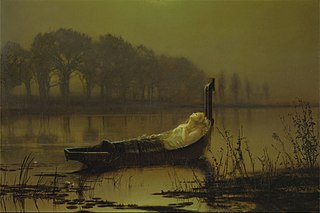
"The Lady of Shalott" is a lyrical ballad by the 19th-century English poet Alfred Tennyson. Inspired by the 13th-century short prose text Donna di Scalotta, it tells the tragic story of Elaine of Astolat, a young noblewoman stranded in a tower up the river from Camelot. One of the poet's best-known works, its vivid medieval romanticism and enigmatic symbolism inspired many painters, especially the Pre-Raphaelites and their followers, and other artists and authors.
The Oxford Book of English Verse, 1250–1900 is an anthology of English poetry, edited by Arthur Quiller-Couch, that had a very substantial influence on popular taste and perception of poetry for at least a generation. It was published by Oxford University Press in 1900; in its india-paper form it was carried widely around the British Empire and in war as a 'knapsack book'. It sold close to 500,000 copies in its first edition. In 1939, the editor revised it, deleting several poems that he regretted including and adding instead many poems published before 1901 as well as poems published up to 1918. The second edition is now available online.
De Vere is a surname. Notable people with the surname include:
Godiva or Lady Godiva was an Anglo-Saxon noblewoman who, according to legend, rode naked through the streets of Coventry, in England, in order to gain a remission of the oppressive taxation imposed by her husband on his tenants.

"Godiva" is a poem written in 1840 by the poet Alfred, Lord Tennyson when he was returning from Coventry to London, after his visit to Warwickshire in that year. It was first published in 1842, no alteration was made in any subsequent edition.

"Lady Clara Vere de Vere" is an English poem written by Alfred Tennyson, part of his collected Poems published in 1842. The poem is about a lady in a family of aristocrats, and includes numerous references to nobility, such as to earls or coats of arms. One such line from the poem goes, "Kind hearts are more than coronets, and simple faith than Norman blood." This line gave the title to the film Kind Hearts and Coronets. Lewis Carroll's poem "Echoes" is based on "Lady Clare Vere de Vere".
A daydream is a fantasy that a person has while awake.
Shalott most commonly refers to:

The Lady of Shalott is a painting of 1888 by the English painter John William Waterhouse. It is a representation of the ending of Alfred, Lord Tennyson's 1832 poem of the same name. Waterhouse painted three versions of this character, in 1888, 1894 and 1915. It is one of his most famous works, which adopted much of the style of the Pre-Raphaelite Brotherhood, though Waterhouse was painting several decades after the Brotherhood split up during his early childhood. The Lady of Shalott was donated to the public by Sir Henry Tate in 1894 and is usually on display in Tate Britain, London, in room 1840.

Somersby is a village in the East Lindsey district of Lincolnshire, England. It is situated 6 miles (9.7 km) north-west from Spilsby and 7 miles (11 km) east-north-east from Horncastle. The village lies in the civil parish of Greetham with Somersby in the Lincolnshire Wolds, a designated Area of Outstanding Natural Beauty; the parish covers about 600 acres (2.4 km2).
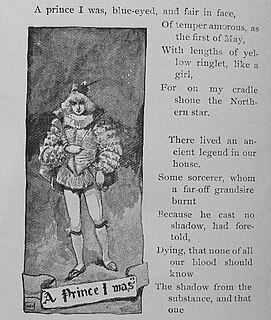
The Princess is a serio-comic blank verse narrative poem, written by Alfred Tennyson, published in 1847. Tennyson was Poet Laureate of the United Kingdom from 1850 to 1892 and remains one of the most popular English poets.
The Princess may refer to:

"The Day-Dream" is a poem written by Alfred Tennyson that was published in 1842. It was an expanded version of his 1830 poem "The Sleeping Beauty". It was further altered in 1848 for a dramatic performance for a private gathering with Tennyson starring as the Prince. The Day-Dream discusses the nature of sleeping and of dreaming, especially in relation to individuals that would want to escape from reality. The poem also compares the act of poetry with dreaming and asserts that the two are the same.
The Lady Clare is a 1919 British silent drama film directed by Wilfred Noy and starring Mary Odette, Jack Hobbs and Charles Quatermaine. It is based on the narrative poem Lady Clare by Lord Tennyson.
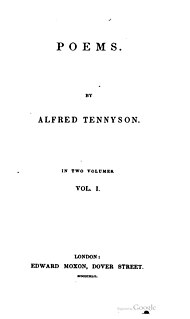
Poems, by Alfred Tennyson, was a two-volume 1842 collection in which new poems and reworked older ones were printed in separate volumes. It includes some of Tennyson's finest and best-loved poems, such as Mariana, The Lady of Shalott, The Palace of Art, The Lotos Eaters, Ulysses, Locksley Hall, The Two Voices, Sir Galahad, and Break, Break, Break. It helped to establish his reputation as one of the greatest poets of his time.
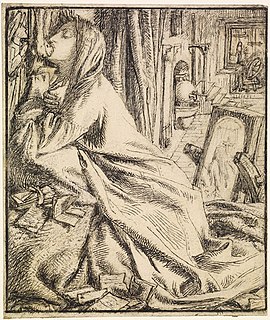
"Mariana in the South" is an early poem by Alfred Tennyson, first printed in 1833 and significantly revised in 1842.
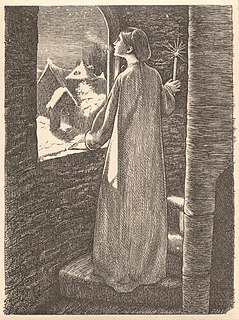
"St. Agnes" is a poem by Alfred Tennyson, first published in 1837, revised in 1842, and retitled "St. Agnes' Eve" in 1857.
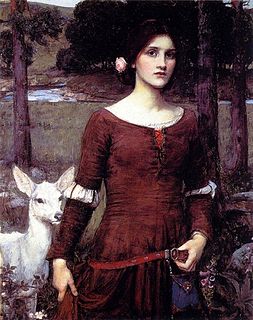
Lady Clare is a narrative poem by Alfred Tennyson, first published in 1842.